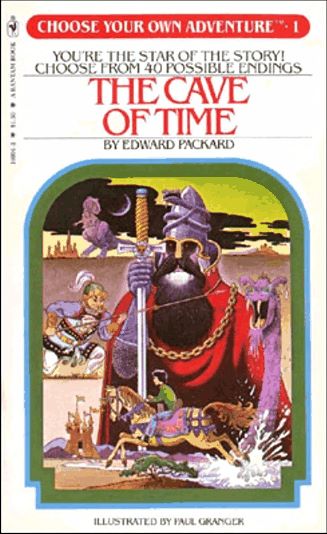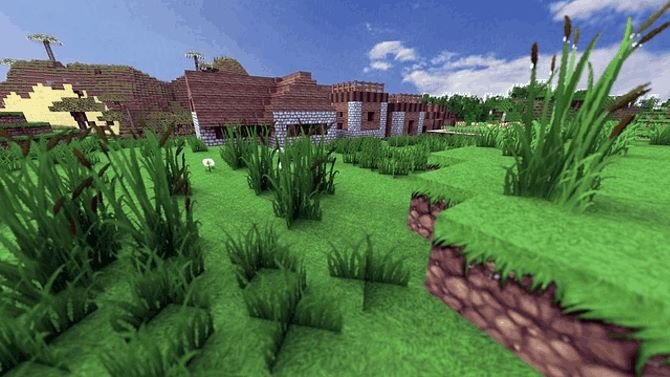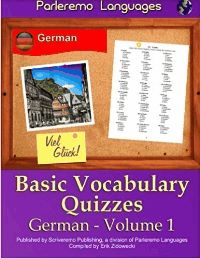
|
Choose Your Own Adventure Up to this point, the games have been essentially drills, and while these are useful, they can't really advance a person in a language beyond a certain point. Another method has to be used, and that involves reading.  Choose Your Own Adventure book, representing a more complex gamification method Back in the late 1980's and early 1990's, there was a popular series of books called "Choose Your Own Adventure". As the title suggests, the reader was part of the story and they had to make decisions which affected how the story went. The flow was surprisingly simple: a person reads a few paragraphs which describe what is going on. After that, they are given a few choices as to what they want to do, and each choice tells them what page to turn to in order to continue. Once they turn to the right page, they are given more of the story to read and more choices. This kind of game emphasizes the person's ability to read and it can easily be done with a computer. The reading itself could be enhanced by offering complete or partial translations of the text, so that both beginner and advanced readers could use the system. The problem with this setup is in the amount of design involved in creating the stories. Most people have a difficult time writing a single story of any length, and this requires multiple variants of the same story. Even if a person does write all the variants and paths, in order for many people to use it, every part has to be translated into other languages. That amount of preparation is why, despite this being such an interesting and fun idea, few places actually take the time to build it. Such a creation would involve a lot of good writers and translators. We Are On a Mission While the multiple choice adventure game is difficult to implement, there is an even more complicated system to build, and thus it remains a sort of "Holy Grail" in the language learning world. That is the fully interactive "quest", which allows players to explore a world, interacting with other characters, either artificial or real players, while practising their reading and vocabulary skills.  A 3D world which allows members to go on quests. Another example of mixing games and learning There are actually two possible forms this layout could take. The first is all text. Similar to the early computer adventure games like Zork, a player would be told what they see, and they can then type in commands for what they want to do. This is far more complex than the Choose Your Own Adventure method, because while that one gives you limited choices, this approach needs to be able to interpret what you tell it and react to it. Normally, this could involve puzzles to solve, often requiring you to perform certain tasks or finding specific items before something else can be done. This kind of interaction is difficult at the most basic level, because the computer would have to be able to properly understand the input from a person who is just learning a language. For a human, this is a rather simple daily function, but for a computer which has no real understanding, it is very complex. The other version involves a video game like interface, allowing a person to move around in a two or three dimensional world using keys or a mouse, rather than typing commands. Along the way, they could encounter other people and items and perform simple tasks, like picking up an object or speaking to a person. For this case, speaking to a pretend person is normally done using a simple reply to the characters text. For example, one character might ask in Italian how they are doing, and the player could choose from a few different possible answers, to which the character is programmed to handle. This is more like the Choose Your Own Adventure, but since you have more control over where you go and what you choose, the game play is much more versatile. As you can see, this final method is very close to a full immersion game, but requires the greatest amount of time and effort create. An entire playing area has to be mapped out and put into an interactive system, while all the characters have to be programmed with what to say and how to react. I have seen a few people trying to put such a gaming system into place, usually asking for a few thousand dollars in donations to make it work, but I haven't yet seen a working game. Conclusion Gamification is a serious business. Applying gamification to something as complex as language learning is particularly difficult, and each method has its drawbacks and limitations. Even though I wrote a good amountt of detail on each, there are far more issues involved with all of them, as well as variations. I would like to hear your own experiences with language learning gamification, as well as any of the methods you've seen that I didn't list. Play on! |
| Playing Games with Language | ||||||||
| Writer: | Erik Zidowecki | |||||||
| Images: | ||||||||
| ||||||||
| Sources: | ||||||||
| ||||||||
Jimmy Mello retains all copyright control over his images. They are used in Parrot Time with his expressed permission.
Maureen Millward retains all copyright control over her images. They are used in Parrot Time with her expressed permission.
All images are Copyright - CC BY-SA (Creative Commons Share Alike) by their respective owners, except for Petey, which is Public Domain (PD) or unless otherwise noted.
comments powered by Disqus



















